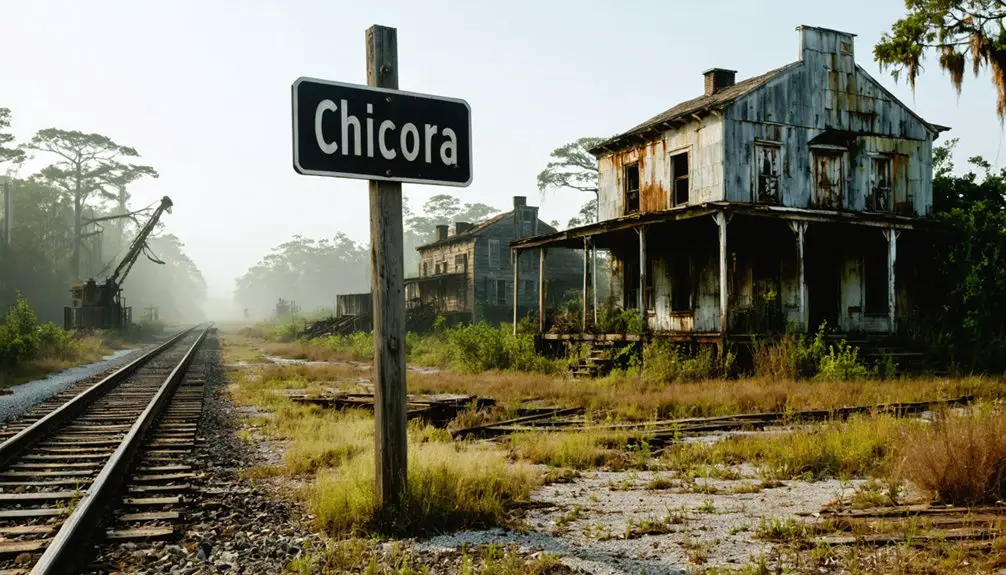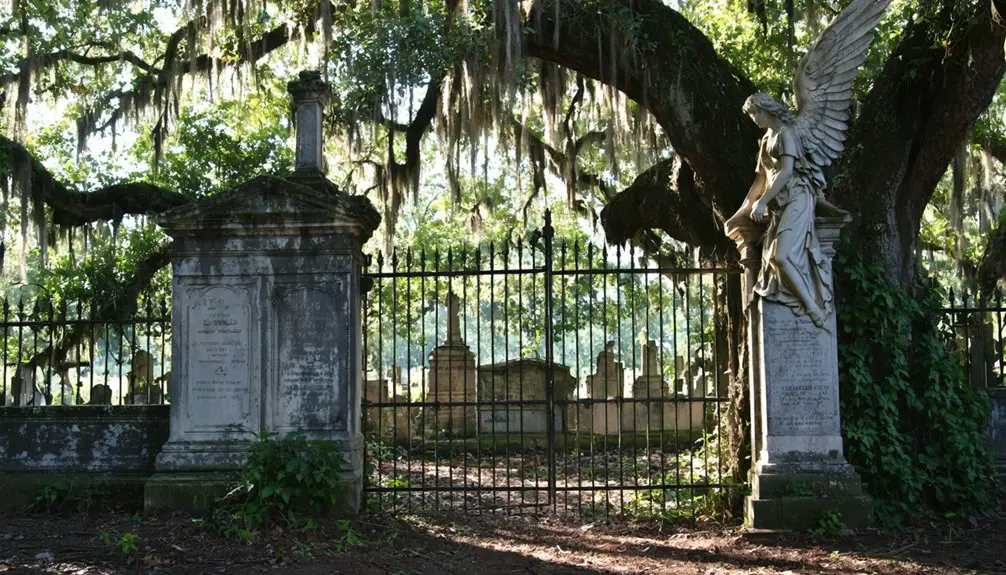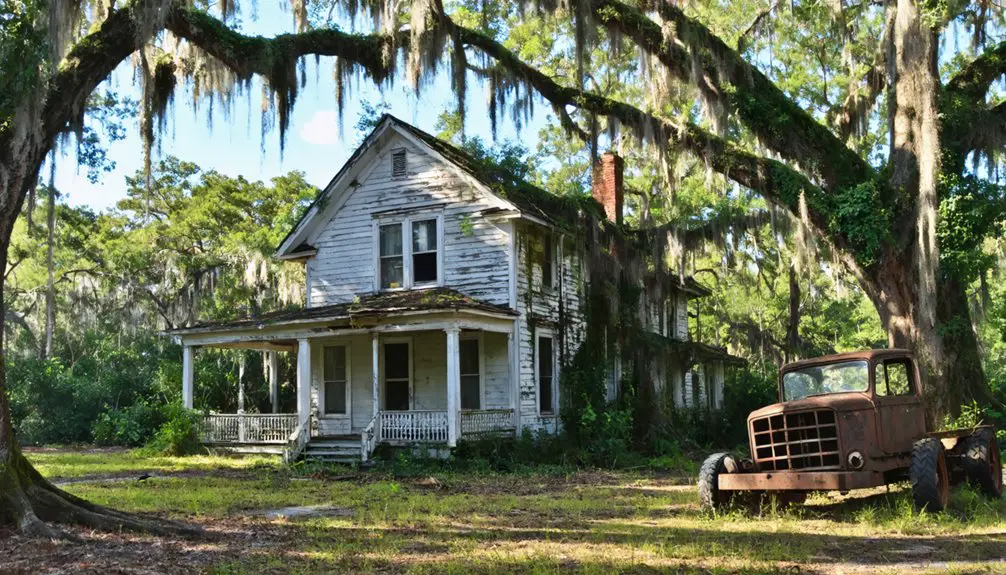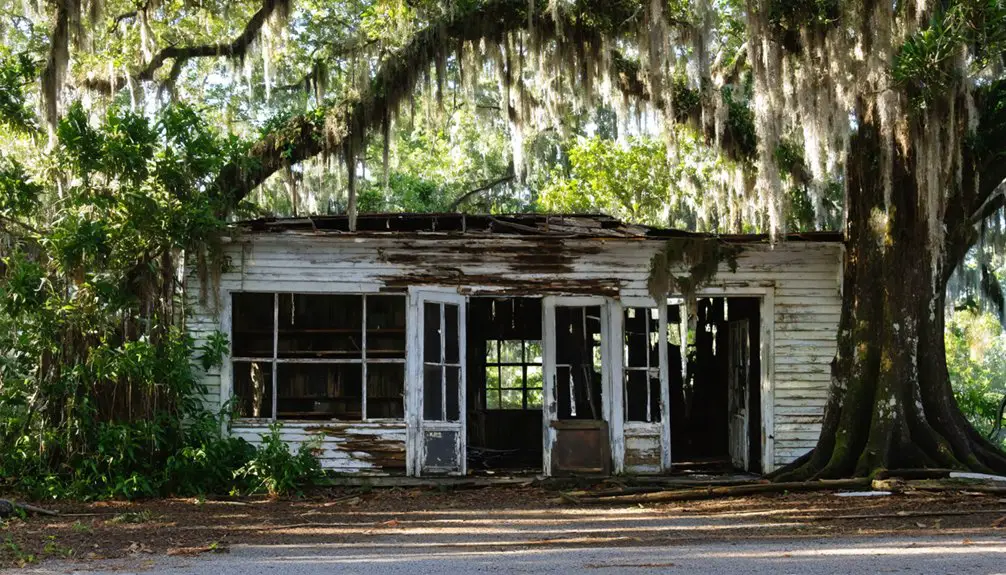You’ll find Old Chicora’s remains in Hillsborough County, Florida, where it thrived as a bustling phosphate mining and timber settlement in the late 1800s. The community boasted hundreds of residents, a hotel, newspaper, schools, and churches during its peak years. By the 1930s, devastating fires destroyed the sawmills, leading to an 80% population decline. While most residents relocated south to Brewster, Chicora’s cemetery grounds and church foundations still whisper stories of its pioneering past.
Key Takeaways
- Chicora was a thriving 19th-century Florida settlement with essential infrastructure, including docks, post office, hotel, newspaper, schools, and churches.
- The town’s economy relied heavily on phosphate mining and timber operations until devastating fires destroyed lumber facilities in the 1930s.
- Population declined 80% after economic collapse, with failed attempts at citrus farming and cattle grazing unable to revive the community.
- Residents migrated south to Brewster (New Chicora) for better phosphate mining opportunities, leaving Old Chicora to fade into abandonment.
- Historical remnants include the Bethlehem Primitive Baptist Church site, cemetery grounds, and Chicora School’s foundation, preserving the ghost town’s legacy.
The Rise and Fall of Old Chicora
In the late 19th century, Old Chicora emerged as a bustling Florida settlement, strategically positioned to capitalize on the region’s abundant natural resources and transportation networks.
You’ll find that the town quickly established itself with essential infrastructure including riverside docks, a post office, and a stagecoach stop that connected settlers to the wider world.
While local legends and ghost stories now echo through its abandoned streets, Chicora once thrived on phosphate mining and timber operations. The town supported hundreds of residents with a hotel, newspaper, schools, and churches. Similar to many Florida ghost towns, brick chimneys still stand as silent sentinels of its former prosperity.
Beneath the ghostly ruins of Old Chicora lies the memory of a vibrant mining town that once pulsed with commerce and community.
However, when the phosphate industry declined and transportation routes shifted elsewhere, Chicora’s prosperity faded. By the Great Depression, many residents had departed, leaving their homes and businesses to slowly dissolve into the Florida wilderness. The Sherman Mill Company created significant employment opportunities, causing the population to surge from 125 to 587 residents by 1930.
Location and Geographic Significance
Located at 27°43’33″N and 82°3’43″W, Old Chicora stands as a tribute to Florida’s phosphate mining heritage within Hillsborough County.
You’ll find this ghost town nestled among the region’s characteristic rolling hills and river valleys, where its geographic features played a critical role in shaping the community’s historical significance.
The town’s strategic position offered three key advantages:
- Direct access to rich phosphate deposits that fueled the local economy
- Proximity to the Alafia River, essential for transportation and commerce
- Connection to a network of minor country roads linking neighboring communities
The area’s American Cyanamid Company established extensive mining operations here in the early 1900s, following the region’s phosphate boom.
Today, you’re just 7.3 km from Alafia River State Park and surrounded by mixed forest and wetland ecosystems. The area was historically known as Old Chicora before transitioning to its current name of Brewster.
The landscape tells the story of Old Chicora’s past, preserved within the natural beauty of central Florida’s terrain.
Early Settlement and Community Life
The first non-native settlers you’d find in Chicora around 1894-1895 were primarily hunters and cattlemen, with James Carlton recognizing the area’s agricultural promise due to its unique soil composition of moisture-retentive red clay beneath sugar sand. These early settlers benefited from the abundant fish and game available in the region. Just like the town of Osceola that would later emerge, Chicora experienced a period of bustling activity.
Early family settlements clustered near the sawmill operation, where you’d see approximately 42 worker houses and a community building that served as the hub for social gatherings.
The town’s social structure reflected the era’s segregation, with separate areas for black and white residents, including distinct housing zones and a “colored” schoolhouse for the children of black workers who made up nearly half the population.
Pioneer Farming Activities
Pioneer farming in Chicora flourished through resourceful agricultural practices that combined subsistence crop cultivation with hunting and fishing.
You’d find settlers making the most of fertile soils exposed by drainage projects, growing vegetables and tropical fruits suited to Florida’s climate. The purchase of land by Hamilton Disston in 1881 helped reveal rich soil perfect for farming through extensive drainage efforts. The Fence Cutting Albrittons fought to protect their farmland access against encroaching phosphate companies in 1920.
When the *Providencia* shipwrecked in 1878, enterprising farmers salvaged coconuts, establishing groves that shaped the local economy.
They’d craft tools by hand and construct buildings from native materials like palmetto thatch and salvaged wood.
Key aspects of Chicora’s farming success:
- Water access through Paynes Creek, despite conflicts with phosphate companies
- Communal resource sharing and bartering of surplus crops
- Integration of hunting and fishing to supplement agricultural yields
Early Family Settlements
While Spanish explorers first encountered the Chicora region in 1521, permanent family settlements wouldn’t take root until the early pioneers arrived in the mid-1800s.
The Spanish attempt at colonization through San Miguel de Gualdape had failed centuries earlier, largely due to poor planning, disease, and conflicts with local indigenous peoples. This harsh lesson would influence how later family settlements approached establishing their homesteads. The early colony’s failure was hastened by its poor soil conditions, which made growing food nearly impossible. After capturing 60 native slaves, the Spanish had destroyed any chance of peaceful coexistence with local tribes.
You’ll find that early settlers learned to cultivate the land much like the indigenous peoples before them, growing corn and beans while raising livestock.
Family dynamics played a vital role in survival, with each member contributing to daily tasks. Unlike the failed Spanish settlement, these pioneers established sustainable communities by adapting to local conditions and maintaining more peaceful relations with neighboring populations.
Church and Social Gatherings
Since its incorporation in 1871, Bethlehem Primitive Baptist Church stood as Chicora’s spiritual and social cornerstone, bringing together scattered homesteaders for worship and fellowship.
The church’s cultural heritage evolved from early services in homes to a permanent concrete-block structure in 1960, preserving community traditions through changing times.
Sacred Harp singing became the heart of Chicora’s church life, with three distinct features:
- Fifth Sunday gatherings drawing up to 45 participants
- Communal meals strengthening social bonds at noon
- Regional connections with singers from Tallahassee, Gainesville, and Georgia
Today, while Chicora exists as a ghost town, the church’s legacy endures through its cemetery, seasonal singings, and the continuing practice of Sacred Harp traditions that have united the community for nearly a century.
Transition to New Chicora (Brewster)

You’ll find that Old Chicora’s community began migrating south in the early 1900s, drawn by the promise of phosphate mining jobs and improved rail access in what would become New Chicora (Brewster).
The move reflected broader economic shifts in Polk County, as phosphate operations reshaped the region’s landscape and employment opportunities.
The change transformed a rural settlement into a company town, with American Agricultural Chemical Company establishing worker housing, mining facilities, and essential services at the new location.
Moving Population South
As environmental pressures and economic opportunities emerged in the late 19th century, Chicora’s population gradually shifted southward toward the newly established settlement of Brewster.
The migration patterns followed established waterways and transport routes, reflecting careful consideration of resource accessibility and strategic advantages.
You’ll find these key aspects of the population dynamics:
- Settlement choices favored locations with Andalusian-like climates and flora, supporting familiar agricultural practices.
- Communities maintained their social networks while adapting to new plantation infrastructures.
- Archaeological evidence shows multilayered occupation sites, revealing a gradual evolution rather than sudden relocation.
This southward movement wasn’t just a change in location – it represented your ancestors’ pursuit of better economic prospects while preserving their cultural identity through carefully selected environments that mirrored their original homeland.
Economic Drivers Behind Relocation
The economic landscape of late 19th century Florida shaped the mass exodus from Chicora to Brewster, building upon the established migration patterns of earlier settlers.
You’d have found Brewster’s modern mining infrastructure and richer mineral deposits creating substantial economic opportunities that Chicora couldn’t match. The expanding railroad network made Brewster a strategic hub, while Chicora’s aging infrastructure struggled to meet industrial demands.
Corporate decisions favored Brewster’s promising future, offering higher wages and improved working conditions.
You could’ve seen the stark contrast as Brewster developed diverse amenities – from housing to education – while Chicora faced dwindling resources and mounting environmental challenges.
The local government’s tax incentives and economic diversification efforts in Brewster sealed the town’s destiny as the region’s new economic powerhouse.
Historical Landmarks and Remnants
While most original structures have vanished from Chicora’s landscape, several historical landmarks and remnants offer glimpses into this former Florida settlement’s past.
The Bethlehem Primitive Baptist Church site, marked by its adjacent cemetery, stands as a monument to the community’s religious practices, where shape note singing once echoed through gatherings.
Sacred hymns and shape note melodies once filled the air where only gravestones now mark Bethlehem Primitive Baptist Church’s legacy.
You’ll find the educational legacy preserved in the scattered remnants of Chicora School’s foundation.
Three key landmarks that survive today:
- The historic cemetery grounds near the former Baptist church site
- Foundation remains of the Chicora School, reflecting the town’s civic infrastructure
- Historical markers that help pinpoint the settlement’s footprint at 27°43’33″N 82°3’43″W
These remnants tell the story of a once-thriving rural community that time has nearly erased.
The Chicora Cemetery Legacy

Among Chicora’s most enduring historical records, its cemeteries stand as silent chroniclers of community life dating back to 1885.
You’ll find the Bethlehem Primitive Baptist Church Cemetery at the heart of this legacy, established with the church’s founding in 1871. Matthew Allbritton’s grave marks the first burial in this sacred ground.
Cemetery preservation efforts, led by the Chicora Foundation in 2011, have documented these invaluable sites despite challenges from weathering and overgrowth.
You’ll need permission before conducting any genealogical research here, as these grounds remain protected.
Using specialized tools and techniques, preservationists carefully clean markers and record inscriptions that reveal family histories, demographic patterns, and religious ties.
These burial grounds tell the stories of early settlers, institutional residents, and the faithful who once called Chicora home.
Economic Forces Behind Abandonment
Following years of intensive lumber extraction, Chicora’s economic fate hinged precariously on its sawmill operations until the mid-1930s. The town’s rigid system of economic dependence trapped workers in a cycle of company store purchases through scrip wages, stifling local enterprise and wealth circulation.
When devastating fires struck the lumber facilities, you’d witness three major consequences:
- Population plummeted 80% within months
- Commercial buildings shuttered as businesses failed
- Workers fled to larger towns like Lake Placid
Though some residents attempted agricultural shifts with citrus groves and cattle grazing, these ventures couldn’t stem the community decline.
Failed oil exploration and a short-lived prison camp proved equally futile. Without economic diversification, Chicora exemplified the harsh reality of Florida’s boom-and-bust extraction economies.
Notable Families and Settlers

The rich tapestry of Chicora’s settlement began with early Spanish contact in 1521, when explorers encountered Native Americans in the southeastern region.
Francisco de Chicora emerged as a significant figure during these early interactions, though no direct lineage of original Native families persisted in later records.
Francisco de Chicora left his mark on early colonial history, yet the native peoples he represented vanished from historical documentation.
Pioneer families began establishing roots in the 1890s, with James “Jimmie” Carlton recognizing the area’s agricultural potential.
By 1915-1917, five homesteads marked the emergence of a small but growing community.
Dr. John Conkle Small’s botanical expertise influenced local naming, while settlement dynamics reflected clear social stratification.
African American families, comprising more than half the population, lived primarily south of the mill in shotgun houses, creating a close-knit workforce community despite economic restrictions imposed by the company scrip system.
Preserving Chicora’s Memory
Modern preservation efforts for Chicora face significant challenges due to Florida’s historically weak preservation culture and rapid development pressures.
You’ll find that community engagement has been essential in documenting what remains of this forgotten town, with organizations like the Chicora Foundation leading important research efforts.
To understand Chicora’s preservation strategies today:
- Historical documentation relies heavily on cemetery research and institutional records
- Natural overgrowth threatens to completely obscure remaining physical structures
- Local oral histories help fill gaps where physical evidence has disappeared
You can see how Florida’s late start in historic preservation has impacted sites like Chicora, where the “preservation-less environment” means you’re often witnessing the results of neglect rather than deliberate conservation.
Despite these challenges, collaborative efforts between state agencies and preservation groups continue to protect what remains of Chicora’s heritage.
Frequently Asked Questions
What Native American Tribes Originally Inhabited the Chicora Area Before Settlement?
60 Chicora tribe members were captured by Spanish explorers in 1521. You’ll find these Native Americans first inhabited coastal settlements near today’s South Carolina, maintaining rich tribal history around Winyah Bay.
Are There Any Documented Paranormal Activities Reported at the Chicora Cemetery?
You won’t find documented ghost sightings or cemetery lore at Chicora Cemetery. Despite Florida’s rich history of haunted burial grounds, research sources don’t mention any verified paranormal activity at this location.
What Was the Average Property Value in Chicora During Its Peak?
You can’t determine precise property values since the lumber company owned most buildings and paid workers in scrip, creating a controlled property market rather than true economic conditions reflecting market prices.
Did Any Famous Outlaws or Notable Criminals Pass Through Chicora?
You won’t find famous outlaws or notable criminals in Chicora’s story. Despite Florida’s wild frontier reputation during that era, historical records and local accounts don’t show any documented criminal presence passing through.
What Natural Disasters or Epidemics Contributed to Chicora’s Decline?
You won’t find direct evidence linking specific hurricane impacts or disease outbreaks to Chicora’s decline, though the region’s settlements commonly faced both threats during Florida’s challenging late 19th century period.
References
- https://www.youtube.com/watch?v=ov9YSsKtbDs
- http://wikimapia.org/11336535/Old-Chicora
- https://99wfmk.com/chicora-michigan-2020/
- https://www.ghosttowns.com/states/fl/chicora.html
- https://en.wikipedia.org/wiki/List_of_ghost_towns_in_Florida
- https://www.florida-backroads-travel.com/florida-ghost-towns.html
- https://www.youtube.com/watch?v=kXGAKmjGMXg
- https://www.wikiwand.com/en/articles/List_of_ghost_towns_in_Florida
- https://www.nomos-elibrary.de/10.5771/9781442243576.pdf
- https://freepages.history.rootsweb.com/~gtusa/usa/fl.htm



